

 |
 |
|
 |
|
| About Us |
|
Read Past Issues | Resources | Composer Links |
The prize was established in 1953 to recognise and support the work of "prominent composers who have become internationally known and acknowledged". It has been awarded only ten times since Jean Sibelius received the inaugural award in 1953 and Lindberg now joins the elite rank of previous winners including Dmitri Shostakovich (1958), Igor Stravinsky (1963), Benjamin Britten (1965), Olivier Messiaen (1971) and György Ligeti (2000). Lindberg is one of the most acclaimed European composers of his generation, particularly admired for his thrilling and virtuoso orchestral scores. His Concerto for Orchestra was premiered in London in September by the BBC Symphony Orchestra with Jukka-Pekka Saraste, and future projects include a new orchestral work for the Los Angeles Philharmonic for May 2004 and a commission for Simon Rattle and the Berlin Philharmonic Orchestra. Lindberg was born in Helsinki in 1958. Following piano studies he entered the Sibelius Academy where his composition teachers included Einojuhani Rautavaara and Paavo Heininen. The latter encouraged his pupils to look beyond the prevailing Finnish conservative and nationalist aesthetics, and to explore the works of the European avant-garde. This led around 1980 to the founding of the informal grouping known as the Ears Open Society including Lindberg and his contemporaries Hämeeniemi, Kaipainen, Saariaho and Salonen, which aimed to encourage a greater awareness of mainstream modernism. Lindberg made a decisive move in 1981, travelling to Paris for studies with Globokar and Grisey. During this time he also attended Donatoni’s classes in Siena, and made contact with Ferneyhough, Lachenmann and Höller. His compositional breakthrough came with two large-scale works, Action-Situation- Signification (1982) and Kraft (1983-85), which were inextricably linked with his founding with Salonen of the experimental Toimii Ensemble. This group, in which Lindberg plays piano and percussion, has provided the composer with a laboratory for his sonic development. His works at this time combined experimentalism, complexity and primitivism, working with extremes of musical material. During the late 1980s his music transformed itself towards a new modernist classicism, in which many of the communicative ingredients of a vibrant musical language (harmony, rhythm, counterpoint, melody) were re-interpreted afresh for the post-serial era. Key scores in this stylistic evolution were the orchestral/ ensemble triptych Kinetics (1988), Marea (1989-90) and Joy (1989-90), reaching fulfilment in Aura (1993-94) and Arena (1994-95). Recent
works, including the concert-opener Feria (1997), large-scale orchestral
statements such as Fresco (1997) and Cantigas (1999), and concertos for
cello (1999) and clarinet (2002), have established Lindberg as one of the
most invigorating of composers working in the orchestral field. Lindberg’s
music has been recorded on the Deutsche Grammophon, Sony, Ondine and Finlandia
labels.
|
|
The Mathematics of Resonant Bodies
I¹ve always envied the hands-on relationship that painters and sculptors have with the materials of their art. The real substance of music always seems just beyond our reach. Still, music is a tactile phenomenon. The musician touches the instrument, and the sound passes through time and space to touch the drums of our ears. I¹ve always loved percussion for its physical presence and for the rich complexity of its sounds. More than any other family of instruments, percussion embodies touch. As Steven Schick observes, the essence of percussion is: "No instruments, only sticks." It¹s the element of touch that makes percussion specific. Different instruments played with the same sticks can sound like a single instrument. And the same instrument played with different sticks can sound very different. Unlike pianos, clarinets and most other instruments, the sounds of individual drums, cymbals, triangles and gongs can vary greatly. When the percussionist travels, he may or may not carry his own instruments. But he always carries his sticks. In a very real sense, the sticks are the instrument. Our ears understand this. We rely on touch to identify sounds. It¹s primarily the first few milliseconds of a sound (the "attack") that we use to distinguish one timbre from another. But what about the rest of the sound? If the attack gives a sound its name, how do we hear its inner life? Several years ago I composed Strange and Sacred Noise, a cycle for percussion quartet celebrating noise in music and in nature. One of the Noise pieces is scored for four tam-tams, playing waves of different periods that eventually crest together in an enormous tsunami of sound. When I first heard this piece (which was written for and premiered by the wonderful Percussion Group Cincinnati) I was startled. Amid the dense masses of broad-band noise I clearly heard voices, like a choir singing long wordless tones. I called these "angel voices". And I wanted to hear them alone. Working with a recording of the tam-tams I filtered out most of the noise (in essence removing the sticks) until all that was left was that choir of angel voices. This became the point of departure for a new exploration of noise. All noise contains pure tone. And the complex sonorities of percussion instruments conceal choirs of inner voices. In The Mathematics of Resonant Bodies my search has been to find and reveal those voices. I began this work by composing a new cycle of quartets. Steve Schick came to Alaska and recorded these one part at a time. I assembled the recordings and then began filtering them as I¹d previously done with the tam-tams. The result was a series of "auras" derived from the inner resonance of the instruments themselves. As the final step, I composed a series of solo parts to be performed within these sonic fields. All the instruments in Resonant Bodies are noise instruments. They¹re also generic. Snare drums, tom-toms, bass drums, cymbals and tam-tams are mainstays of Western percussion. And although each individual instrument sounds different, in a general sense they all sound alike. So it¹s the percussionist (with his sticks and his touch) who makes them specific, who gives them their particular names and profiles. Like the listener, the soloist in these pieces is a solitary figure traversing enveloping landscapes of resonance. An Interview with Tobias Picker Handmaid Tale's Debuts in English Rautavaara Joins B&G Who's Afraid of Julia Wolfe Derek Bermel's Soul Garden The Pianist: The Extraordinary True Story of Wladyslaw Szpilman John Adams' Atomic Opera A Bridge Not Far Enough Turnage Signs With B&H Sophie's Wrong Choice Copland's Mexico On Being Arvo Rzewski Plays Rzewski Praising Lee Hyla David Lang's Passing Measures Three Tales at BAM Naxos at 15 On the Transmigration of Souls Dead Man Walking David Krakauer's The Year After Steve Reich/Alan Pierson |
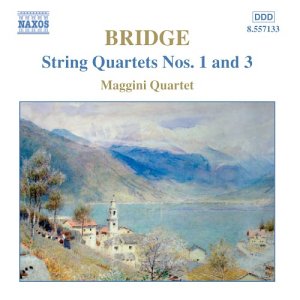
String Quartets 1 & 3 Composer: Frank Bridge Performers:. Maggini String Quartet Naxos Frank Bridge is a bit of a lost horse in the English stable of composers that includes such giants as Elgar, Vaughan Williams and, his student, Benjamin Britten. But he shouldn't be. No. 1, written in 1901, is a mature, fully realized work; No. 3, composed in 1927 is one of the pilars of 20th century chamber music. As always, the Maggini play magnificiently and the recording is first rate. |
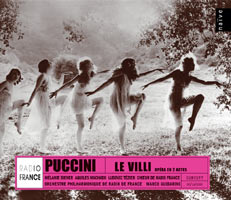
Le Villi Composer: Giacomo Puccini Conductor: Marco Guidarini Performer: Melanie Diener, Ludovic Tezier, et al. Radio France Chorus, French Radio Philharmonic Orchestra Naive Just
listening to young Puccini's first opera (as opposed to seeing it staged
and sung), you notice immediately that the big sweeping melodies, the ingenious
"hooks" are already there. Naive has also issued a Radio France recording
of Puccini’s second opera, Edgar,
written five years after Le Villi. In this more ambitious and
complicated work, Puccini develops his technique using a score that merges
stirring arias and ensembles.
|
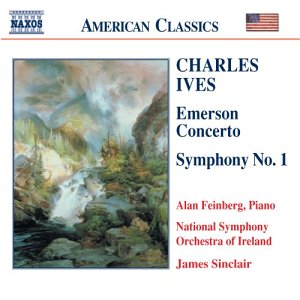
Emerson Concerto / Symphony 1 Composer: Charles Ives Performers: Alan Feinberg (piano), National Symphony Orchestra of Ireland, James Sinclair (conductor) Naxos Ives sketched the Emerson Concerto in 1907 but never fully finished it, although he used portions in other works. David G. Porter, a noted Ives scholar, was able to create a performing version which was premiered in 1998 by Alan Feinberg, the pianist on this premiere recording. The piece is extremely demanding, often abrasive, and demands exceptional virtuosity. Symphony No. 1 is fetching, but not as charateristic, of the great American maverick that followed. |
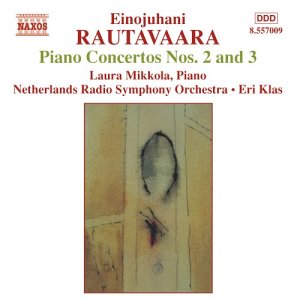
Piano Concertos 2 & 3 Composer: Einojuhani Rautavaara Performers: Laura Mikkola (piano), Netherlands Radio Symphony Orchestra, Eri Klas (conductor) Naxos The Finnish composer Rautavaara has enjoyed enormous success in recent years with his unique blend of northern lights impressionism and romanticism served up in an aura of modernity. His Cantus Articus is immensely popular, conjuring up associations of Messiean, although the latter is a much more important composer. The Third Piano Concerto from 1998 is forceful, drawings on the Russian school of pianism, although it not technically flashy until the finale. The Second, composed nine years earlier, is more traditional and Laura Mikkola, already on disc with a highly regarded account of the First Concerto, again provides an outstanding performance. |
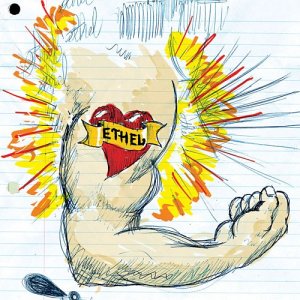
Ethel Composers: King, Kline, Reynolds, Ziporen Performers: Ethel Cantaloupe New
York's most daring string-quartet sensation, Ethel, makes its debut here
with a menu of the kind of hard-edged downtown music that has won the group
a big following in the NY new music scene. Todd Reynolds and
Mary Rowell, violins; Ralph Farris, viola; and Dorothy Lawson, cello—all
began their careers in New York as freelance musicians, playing difficult
music that relies heavily on non-classical sources but requires a virtuoso
classical ensemble to play. Its repertoire ranges from John King's energetic
blues transcriptions to the gnarly quartets of Julia Wolfe
and on Todd Reynolds' quirky
|
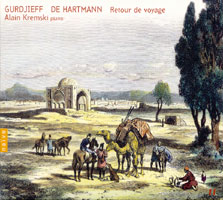
Return from a Journey Composers: Gurdjieff, De Hartmann, Performer: Kremski Naive Gurdjieff
was a Russian Aremenian spiritual master who, in addition to the main body
of his teaching created sacred dances, or Movements, as well as 200
or so musical compositions--all of which were were done in collaboration
with German composer Thomas de Hartmann at Gurdjieff's Institute
for the Harmonious Development of Man, near Paris, in the years 1925–27.
For many years, the pieces heard here were played only by De Hartmann or
another of Gurdjieff's disciples but in recent years they have attracted
the interest of a number of adventuresome pianists. Kremski plays
these exotic, vaguely oriental and oddly thematic pieces with great respect
and warmth.
|
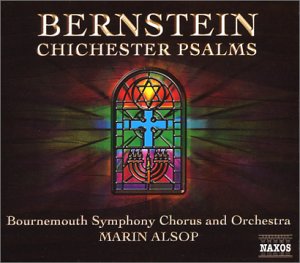 Chichester
Psalms
Chichester
Psalms
Composer: Leonard Bernstein Performers: Bournemouth Symphony Orchestra and Chorus, Marin Alsop (conductor) Naxos Commissioned in 1965 by the Dean of Chichester, Bernstein’s colorful Chichester Psalms is one of the composer’s most successful and accessible works on religious texts, contrasting spiritual austerity with impulsive rhythms in a contemplation of peace. The composer fashioned his Oscar nominated score to the 1954 movie On the Waterfront into a symphonic suite, skillfully capturing the oppression of the New York dockyards in the ’50s. The Three Dance Episodes were extracted from the popular On The Town, Bernstein's first successful foray into musical theatre. Bernstein protege Marin Alsop gets a robust performance from Bournemouth orchestra and chorus. |
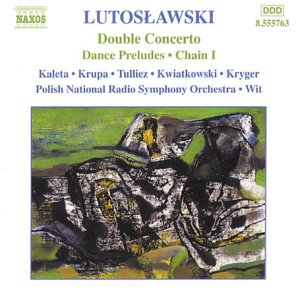
Double Concerto Composer: Witold Lutoslawski Performers: Polish National Radio Symphony, Antoni Wit Volume 8 in Naxos' indispensible survey of Lutoslawski's orchestra work brings us into lesser known territory but there are still treasures to be found. The Dance Preludes from 1955 is basically a five-movement clarinet concerto, with lots of interesting harmonies and rhythmic twists and turns. The Double Concerto for oboe and harp from 1990 rattles the ear a bit and has a demanding oboe part, beautifully played by Arkadiusz Krupa. The Children's Songs, gorgeously sung by the soprano, Urszula Kryger, are beguiling. |
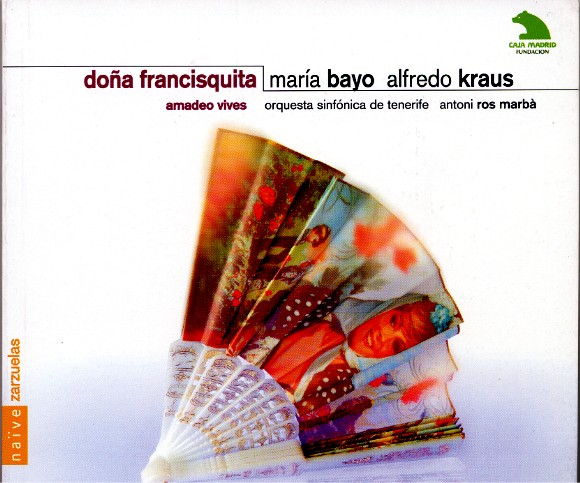
Doña Francisquita Composer: Amadeo Vives Performers: Maria Bayo, Alfredo Kraus, Orquesta Sinfonica de Tenerife, Antoni Ros Marba Naive A superb performance of Amadeo Vives' zarzuela masterpiece, sung with enormous vivacity and brio by the ravishing-voiced Maria Bayo and the sturdy Alfredo Kraus. With its nineteenth century Madrid setting, its roots in classical Spanish drama and its festive nocturnal amours, Doña Francisquita provides a retrospective on the romantic zarzuela tradition and its crowning glory. The work was immediately recognized not only as Vives’ masterpiece, but as the greatest full length zarzuela of its era. If you're not into zarzuela already, this is the perfect place to start your collection. |
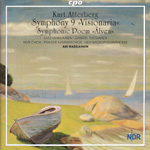
Symphony 9 Visionaria Composer: Kurt Atterberg Satu Vihavainen (mezzo-soprano); Gabriel Suovanen (baritone) NDR Choir, Prague Chamber Choir NDR Radio Philharmonic, Ari Rasilainen CPO The 9th and final symphony of Swedish composer Kurt Atterberg bears a superficial relationshp to Beethoven's 9th with its big, expresssive choral sound but Atterburg's world is a good deal less joyous. Atterberg's choice of texts reflects the lasting impact on his psyche made by World War II and the Korean War. The Poetic Edda, an Icelandic epic dating from around 1270, relates the visions of a wise prophetess (hence the Symphony's title "Sinfonia Visionaria") who foretells the creation of the world, the warring among gods, giants, and humans, the world's destruction, and finally its recreation. Atterberg uses mezzo-soprano and baritone soloists with chorus and large orchestra, as well as a quasi-oratorio form, to tell his epic tale. This is extraordinary symphony by a composer who is far too little-known in the musical world. |
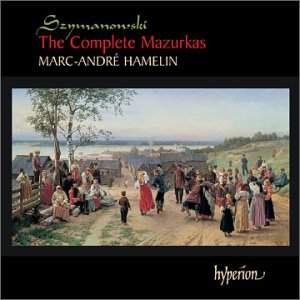
The Complete Mazurkas Composer: Karol Szymanowski Performer: Marc-Andre Hamelin Hyperion Marc-Andre Hamelin continues his extraordinary journey through the forgotten rivers and bayous of the modern piano repetoire with masterful performances of Szymanowski's Twenty Mazurkas, Op. 50, composed between 1926 and 1931. After assimilating the influence of Stravinsky, Szymanowski began looking for folk themes in Polish music to rival the Russian folk touches of the master. The Mazurka, a traditional Polish dance in three-quarter-time with an often erratic-seeming emphasis on the second beat, (and a favorite form for Chopin) offered great possibilities . These highly diverse pieces are more complex than Chopin, more modern and dissonant, yet also more muted and elusive. Still, Szymanowski remained too much a romantic to settle for anything less then flamboyant virtuosity--a quality that Hamelin possses by the truckload. |
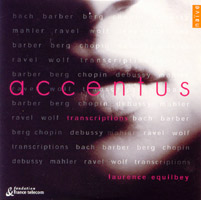
Accentus Composers: Transciptions: Bach, Barber, Berg, Chopin, Debussy, Mahler, Ravel, Wolf Peformers: : Choeur De Chambre Accentus, Equilbey Naive Worth having for the ravishing performances of Samuel Barber's "Adagio" and Mahler's "Adagietto from Symphony No. 5." |
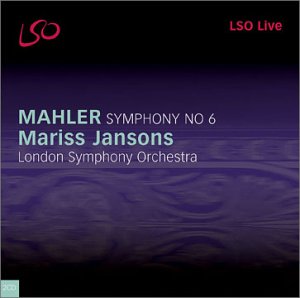
Symphony No. 6 Composer: Gustav Mahler Performer: London Symphony Orchestra; Mariss Jansons Label: LSO Live It is rare that you find a recording that you need listen to for only a minute to know a masterpiece is unfolding before your very ears. This stunning live performance of Mahler's "Tragic" symphony is one of the rare ones, From the first rhythmic thumps of the long and stately funeral march to the final faded chords, Mariss Jansons draws a passionate and committed performance from the LSO. Certain to be among the best of the year noninees. |

Wheel of Emptiness Composer: Jonathan Harvey Performers: Actus Cyprès CYP5604 English composer Jonathan Harvey is one of those modernists whose work is more frequently talked about then played. This rare recording contains five representative works ranging from the lyrical to the raw, built on instrumentations ranging from electroacoustical to the traditional. An excellent introduction to an unjustly neglected maverick. |
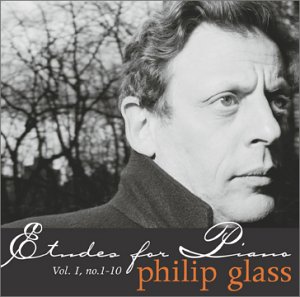
Piano Etudes 1 Composer: Philip Glass Performer: Philip Glass Orange Mountain Glass says he wrote these "studies" as fodder for his own concert performances and as a way of challenging himself as a pianist. But, they are much more important than that. They provide a real insight into how Glass composes and, although billed as sketches, sometimes are more rewarding to the ear and intellect than many of Glass's larger-scale works. Essential recording for the Glassologist. |
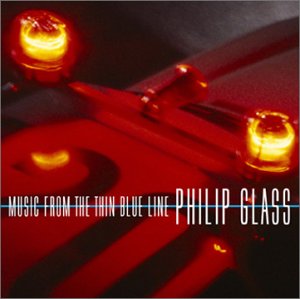
Music from the Thin Blue Line Composer: Philip Glass Orange Mountain Glass's hypnotic score for Errol Morris’ extraordinary 1988 documentary film entitled "The Thin Blue Line". Nonesuch Records released a CD of the film’s soundtrack that included the narration and interviews from the film but this Orange Mountain release contains the original score without the voice-over. The music is dark and brooding, full of tension appropriately for such a chilling film, and it stands well on its own. |
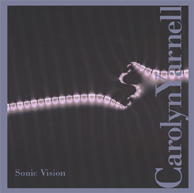
Sonic Vision Composer: Carolyn Yarnell Tzadik Inspired by the beauty and power of nature, the music of Carolyn Yarnell straddles the borders of minimalism, romanticism and Baroque. Sonic Vision, the first CD devoted entirely to her music, contains the powerful electronic composition Love God, a beautiful solo piece for Baroque flute, a minimalist suite for chamber ensemble and a powerful extended work for computer piano. Lyrical and mystical music that evokes volcanoes, birds and the Rocky Mountains. |
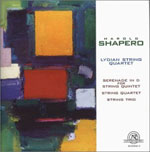
Chamber Music Composer; Harold Shapero Performers: Lydian String Quartet New World Records - Shapero’s (b. 1920) vastly underrated portfolio is one of the great undiscovered treasure troves of American neoclassicism. The String Trio, the String Quartet, the Serenade in D offer a broad-based introduction to Shapero’s compositional thought processes. Beautiful, committed playing by the Lydian String Quartet. |

Drumming Composer: Steve Reich Performer: Ictus, Synergy Vocals Cypres Reich's 1971 masterpiece gets a spirited workout by the Belgian new music group Ictus. Drumming is constructed around one single basic rhythmic-melodic pattern, for an imposing ensemble of percussion (bongos, marimbas, glockenspiel) joined by some female voices, a piccolo flute or a whistling part. The breathtaking feeling of simplicity/complexity in this work is transmitted with an amazing skill by the Belgians. |
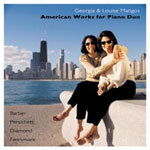
American Works for Piano Duo Composer(s): Barber, Persichetti, Diamond, Fennimore Performer (s): Georgia & Louis Mangos Cedille Records Barber's homage to the Plaza Hotel's Palm Court, Souvenirs, Op. 28, has never sounded better or more nostalgic and Joseph Fennimore's Crystal Stairs also invokes the quintessential American city. The real surprise here are the two pieces by Vincent Persichetti, which invoke a more dynamic and rough and tumble form of Americanism. The Mango sisters display formidable technique and taste. |
 |
Search WWWSearch www.sequenza21.com |
